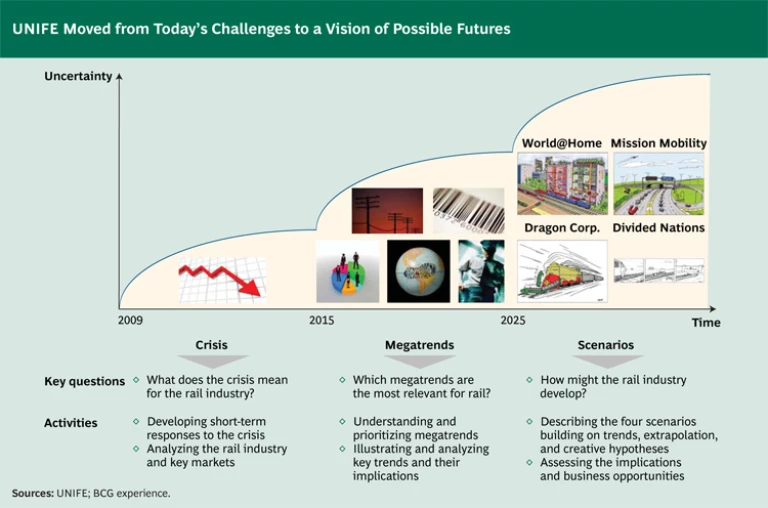What is the probability that, five years from now, you will have to pay for a Google search? “Zero,” most people would say, without missing a beat. Now consider a different question: Suppose that, five years from now, you do have to pay. How did it happen? The same people would offer up a range of possibilities: cash-starved governments are compelled to seek new tax sources; stratospheric energy prices, driven by a global fuel shortage, force Google, with its massive server farms, to start charging for its services; or a game-changing algorithm enables Google to charge for premium search results. In an instant, the impossible has become the plausible.
The “what if?” school of thinking clearly has a place in the business world. For a host of reasons, however, classic scenario planning of the sort pioneered by the legendary Pierre Wack at Shell in the 1970s has fallen out of fashion. Some executives believe that it is too time consuming and resource intensive. Others feel that markets are too changeable for scenarios to be of much help. And to a degree, they’re right. Traditional scenario planning can be hard work that demands a dedicated staff and months of quantitative study. It is best suited to exploring a limited set of key issues that drive the fundamental economics of a business.
But Wack’s approach to scenarios is not the only one. Many of the benefits of scenario analysis—for example, enhanced strategic creativity, greater preparedness, and superior risk awareness—can be achieved more rapidly. The scenarios that emerge are provocative but believable, if improbable. Their value comes not from any explicit predictions but from what the executive team learns during their development and how these lessons are applied.
A New Box for Scenarios
In a previous Perspective titled “Thinking in New Boxes,” we argued that thinking “outside the box” is neither as desirable nor as liberating as it sounds, because the space outside the box is infinite. Faced with limitless possibilities, the human mind feels adrift and tends to fall back into the familiarity of “the box.” People cannot help using mental models, frameworks, and theories—or, as we called them, boxes—to organize their thinking. Thus, a far more powerful approach to spurring creativity is for companies to develop a new set of boxes that free the mind to think the unthinkable—and to do so proactively, before their competitors force them into an inhospitable box by outmaneuvering them.
A well-crafted scenario is, in essence, a new box—it can help a company look at its future from an entirely new perspective. But new-box thinking is relevant to scenarios in a more fundamental way. It can help redefine scenario planning for our more turbulent world. Ask most chief executives if strategically valuable scenarios can be created—and important insights captured and communicated throughout the organization—within a matter of several weeks, and nearly all would say no. But let’s assume—as we did with the Google search example—that it is possible. This is the very challenge that we set for ourselves recently.
We had two hypotheses. First, we believed that the necessary level of engagement and insight could not quickly be achieved without involving the senior management team—under the guidance of an expert facilitator—in both shaping and exploring the scenarios. Second, we believed that by tapping the knowledge of the executives and then combining it with select data on critical megatrends likely to affect the company, its competitors, and its customers, we could rapidly craft scenarios that were at once believable enough to be embraced and radical enough to spur powerful ideas. Our experience has borne out these hypotheses.
From Fact to (Near) Fiction
In 2009, UNIFE, the association of the European rail industry, felt certain that the future would not be a linear projection of the past. The financial crisis and subsequent recession were putting unprecedented stress on customers. Trade patterns were shifting. New competitors were emerging. UNIFE’s members needed to think both more expansively and more creatively. They needed scenarios.
They convened a small working group of executives from major rail companies. This group took four weeks to prepare for a one-day scenarios workshop. They explored data on a carefully selected set of megatrends—such as urbanization, the rise of China, sustainability, terrorism, the increasing scarcity of fossil fuels, and increasing bandwidth and other technology trends—that had some bearing on the future of the rail industry. Eventually, they settled on four “2025 variables” that would be the starting point for the workshop:
- Shipping bananas from Harare to Barcelona
- Preparing a tender for bids to supply trains for a new rail project
- Arriving at New York Penn Station on a Monday morning
- Reading the cover of the 2025 year-end holiday double issue of the Economist
On the day of the scenarios exercise, a broader group of senior executives brainstormed a set of hypotheses for each variable. Their hypotheses had to be plausible and supported by specific industry, macroeconomic, or social trends—yet also improbable, as in the Google example. When imagining possibilities for the 2025 rail tender, for example, UNIFE generated a range of hypotheses, including one in which a winner-take-all tender would be conducted every ten years for the whole of Europe, and another in which customers bought trains through online catalogues, without tenders or bids. (The high-level process that UNIFE went through is represented in the exhibit below.)
They then grouped some of the hypotheses into coherent clusters that could serve as the basis for specific scenarios, ultimately settling on four such clusters. But the four were not yet scenarios. They needed color. Much as in a novel, play, or film, a strong storyline is essential to fostering real intellectual and emotional engagement. By the end of the day, the group had outlined four scenarios.
World@Home. Urbanization and advances in communication enable people to work from home, giving rise to increased productivity. Environmental and nutritional concerns have increased the demand for locally sourced products. People mobility is secondary to the movement of goods.
Mission Mobility. A revolution in energy science spawns new modes of low-cost green transport, leading to the increased movement of both people and goods—and putting greater pressure on the rail industry to differentiate itself in terms of speed, service quality, and price. End customers come to expect seamless intermodal shipping solutions.
Divided Nations. The world economy remains in poor shape. The European Union, World Trade Organization, and other regional trade blocs are breaking down. Protectionism is on the rise and transport is mostly local as a result of rising barriers between regions.
Dragon Corp. The world has bifurcated into two main regions. The West has become poorer, while China, now an industrial and financial powerhouse, dominates the global economy. Chinese rail enterprises lead the world with cutting-edge technology and low costs.
Clearly, none of the four scenarios is likely to unfold in its entirety, but each presented an engaging “box” within which UNIFE members could evaluate existing strategies and imagine radical new ones. After the one-day workshop, communication materials were developed to support the scenarios, enabling the people who were not directly involved in the exercise to understand the rationale and implications of each one. This created a common language that contributed to strategic planning and decision making within and across UNIFE’s member companies.
Members have found these scenarios both provocative and practical as they grapple with how to plan for a changing world. A senior strategy executive at Alstom stated that the scenario-planning day was “intellectually challenging and very refreshing,” and that it also “forced our group to think beyond conventional wisdom and in uncharted territory…The resulting scenarios became a valuable basis for building our long-term strategy.” Another participant, a former international manager of the French railway system, stated that the scenarios, while extreme, were far from academic. “We are already beginning to see that our industry is evolving and facing a mix of the scenarios,” he remarked. The experience has helped member companies to be more attuned to “weak signals” and thus more prepared to adapt to shifts in their markets.
Rethinking Scenarios
The increase in uncertainty and the accelerating clock-speed of many markets, rather than rendering scenarios impractical, is perhaps the strongest argument for embracing them. This new approach to scenarios is not about precision but is instead about expanding the perception of the possible—and breaking an executive team out of a tunneled managerial perspective and into a creative, entrepreneurial, and strategic one. With turbulence on the rise, the value of low-cost ways to envision and seize emerging opportunities while planning for potential threats has never been higher.
What a difference a day makes.








